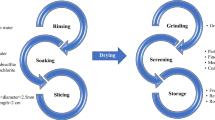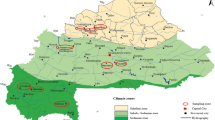Abstract
Effects of soaking, cooking and autoclaving on changes in polyphenols, phytohaemagglutinating activity, phytic acid, hydrogen cyanide (HCN), oligosaccharides and in vitro protein digestibility were investigated in seeds ofDolichos lablab var.vulgaris. Both distilled water and NaHCO3 solution soaking and autoclaving significantly reduced the contents of total free phenolics (85–88%) compared to raw seeds. Autoclaving (45 min) reduced the content of tannins by upto 72%. Soaking seemed to have limited effect in eliminating phytohaemagglutinating activity, whereas autoclaving (45 min) seemed to eliminate the haemagglutinating activity completely. The reduction in content of phytic acid was found to be some what greater in distilled water soaking (28%) compared to NaHCO3 solution soaking (22%). Only a limited loss in content of phytic acid was observed under cooking as well as autoclaving. Loss of HCN was greater under autoclaving (87%) compared to the other processes studied. Of the three sugars analysed, soaking reduced the level of verbascose more than that of stachyose and raffinose. Autoclaving reduced the content of oligosaccharides more efficiently (67–86%) than ordinary cooking (53–76%). Autoclaving improved the in vitro protein digestibility (IVPD) significantly (13%). Of all the different water and hydrothermal treatments studied autoclaving seemed to be the most efficient method in improving IVPD and eliminating the antinutrients investigated except phytic acid.
Similar content being viewed by others
References
Almeida NG, Calderon de la Barca AM, Valencia ME (1991) Effect of different heat treatment on the antinutritional activity ofPhaseolus vulgaris (variety Ojode Cabra) lectin. J Agric Food Chem 39: 1627–1630.
Ayyagari BR, Rao SN, Roy DN (1989) Lectins, trypsin inhibitors, BOAA and tannins in legumes and cereals and the effects of processing. Food Chem 34: 229–238.
Babar VS, Chavan JK, Kadam SS (1988) Effect of heat treatments and germination on trypsin inhibitor activity and polyphenols in jack bean (Canavalia ensiformis L. DC). Plant Foods Hum Nutr 38: 319–324.
Babiker EE, El-Tinay AH (1993) Effect of reconstitution and Na2CO3 on tannin content and in vitro protein digestibility of faba bean cultivars. Plant Foods Hum Nutr 44: 119–130.
Bansal KK, Dhindsa KS, Batra VIP (1988) Trypsin inhibitor and haemagglutinin activities in chickpea (Cicer arietinum L.): Effect of heat and germination. J Food Sci Technol 25: 46–48.
Batra VIP (1978) Effects of cooking and germination on haemagglutinating activity in lentil. The Indian J Nutr Dietet 24: 15–19.
Bender AE, Reaidi GB (1982) Toxicity of kidney beans (Phaseolus vulgaris) with particular reference to lectins. J Plant Foods 4: 15–22.
Bray HG, Thorne WV (1945) Analysis of phenolic compounds. Meth Biochem Anal 1: 27–52.
Burns RR (1971) Methods for estimation of tannin in grain,Sorghum. Agron J 63: 511–512.
Dubois M, Gilles K, Hamilton TK, Rebers PA, Smith F (1956) Colorimetric method for determinations of sugars and related substances. Anal Chem 28: 350–356.
Duffus CM, Duffus JM (1991) Introduction and overview In: Felix D'Mello JP, Duffus CM, Duffus JM (eds),Toxic substances in crop plants. Cambridge, UK: The Royal Society of Chemistry, pp 1–20.
Duhan A, Chauhan BM, Punia D, Kapoor AC (1989) Phytic acid content of chickpea (Cicer arietinum) and black gram (Vigna mungo): Varietal differences and effect of domestic processing and cooking methods. J Sci Food Agric 49: 449–455.
Egbe IA, Akinyele IO (1990) Effect of cooking on the antinutritional factors of lime beans (Phaseolus lunatus). Food Chem 35: 81–88.
Hira CK, Kanwar JK, Gupta N, Kochhar A (1988) Cooking quality and nutritional evaluation of the rice beanVigna umbellata. J Food Sci Technol 25: 133–136.
Hsu HW, Vavak DL, Satterlee LD, Miller GA (1977) A multienzyme technique for estimating protein digestibility. J Food Sci 42: 1269–1271.
Jackson ML (1967) Soil chemical analysis. Madras, India: Asia Publishing House.
Kadam SS, Smithard RR (1987) Effect of heat treatments on trypsin inhibitor and haemagglutinating activities in winged bean. Plant Foods Hum Nutr 37: 151–159.
Kataria A, Chauhan BM, Gandhi S (1988) Effect of domestic processing and cooking on the antinutrients of black gram. Food Chem 30: 149–156.
Kataria A, Chauhan BM, Punia D (1989) Antinutrients and protein digestibility (in vitro) of mungbean as affected by domestic processing and cooking. Food Chem 32: 9–17.
Khan N, Zaman R, Elahi M (1986) Effect of processing on the phytic acid content of wheat products. J Agric Food Chem 34: 1010–1012.
Khan N, Zaman R, Elahi M (1988) Effect of processing on the phytic acid content of bengal grams (Cicer arietinum) products. J Agric Food Chem 36: 1274–1276.
Kumar NR, Reddy AN, Rao KN (1979) Levels of phenolic substances in the leacheates inCicer seed. Indian J Expt Biol 17: 114–116.
Kumar KG, Venkataraman LV, Jaya TV, Krishnamurthy KS (1978) Cooking characteristics of some germinated legumes: Changes in phytins, Ca++ and pectins. J Food Sci 43: 85–88.
Laurena AC, Garcia VV, Mendoza EMT (1986). Effect of soaking in aqueous acidic and alkali solutions on removal of polyphenols and in vitro digestibility of cowpea. Qual Plant — Plant Foods Hum Nutr 36: 107–118.
Laurena AC, Garcia VV, Mendoza EMT (1987) Effect of heat on the removal of polyphenols and in vitro protein digestibility of cowpea (Vigna unguiculata (L.) Walp). Plant Foods Hum Nutr 37: 183–192.
Laurena AC, Rodriguez FM, Sabino NG, Zamora AF, Mendoza EMT (1991) Amino acid composition, relative nutritive value and in vitro protein digestibility of several Phillippine indegenous legumes. Plant Foods Hum Nutr 41: 59–68.
Liener IE (1986) The nutritional significance of naturally occurring toxins in plant food stuffs In: Harris JB (ed),Natural Toxins: Animal, Plant and Microbial. Oxford, UK: Clarendon Press, pp. 73–94.
Lowry OH, Rosebrough NJ, Farr AL, Randall RJ (1951) Protein measurement with folin phenol reagent. J Biol Chem 193: 265–275.
Marfo EK, Simpson BK, Idowu JS, Oke OL (1990) Effect of local food processing on phytate levels in cassava, cocoyam, yam, maize, sorghum, rice, cowpea and soybean. J Agric Food Chem 38: 1580–1585.
Moneam NMA (1990) Effects of presoaking on faba bean enzyme inhibitors and polyphenols after cooking. J Agric Food Chem 38: 1479–1482.
Mukherjee S, Srivastava HS (1952) Improved spray reagent for detection of sugars. Nature 169: 330–331.
Oke OL (1969) The role of hydrocyanic acid in nutrition. Wld Rev Nutr Diet 11: 118–147.
Okolie NP, Ugochukwu EN (1989) Cyanide contents of Nigerian legumes and the effect of simple processing. Food Chem 32: 209–216.
Ologhobo AD, Fetuga BL (1984) Distribution of phosphorus and phytate in some Nigerian varieties of legumes and some effects of processing. J Food Sci 49: 199–201.
Onigbinde AO, Akinyele IO (1983) Oligosaccharide content of 20 varieties of cowpea in Nigeria. J Food Sci 48: 1250–1251, 1254.
Panasuik O, Bills DD (1984) Cyanide contents of sorghum sprouts. J Food Sci 49: 791–793.
Ravindran V, Ravindran G (1988) Nutritional and antinutritional characteristics ofMucuna (Mucuna utilis) bean seed. J Sci Food Agric 46: 71–79.
Revilleza MJR, Mendoza EMT, Raymundo LC (1990) Oligosaccharides in several Phillippine indegenous food legumes: Determination, localization and removal. Plant Foods Hum Nutr 40: 83–93.
Satwadhar PN, Kadam SS, Salunkhe DK (1981) Effect of germination and cooking on polyphenols and in vitro protein digestibility of horse gram and moth bean. Qual Plant — Plant Foods Hum Nutr 36: 71–76.
Siddhuraju P, Vijayakumari K, Janardhanan K (1994) Genetic resources of tribal pulses. FAO/IBPGR Plant Genet Res Newslett 96: 47–49.
Siddhuraju P, Vijayakumari K, Janardhana K (1994) Chemical analysis and nutritional assessment of the less known pulses,Vigna aconitifolia (Jacq.) Marechal andV. vexillata (L.) A. Rich. Plant Foods Hum Nutr 45: 103–111.
Singh U (1988) Antinutritional factors of chickpea and pigeonpea and their removal by processing. Plant Foods Hum Nutr 38: 251–261.
Singh SP, Misra BK, Chandel KPS, Pant KC (1980) Major food constituents of rice bean (Vigna umbellata). J Food Sci Technol 17: 238–240.
Tan NH, Rahim ZHA, Khor HT, Wong KC (1983) Winged bean (Psophocarpus tetragonolobus) tannin level, phytate content and haemagglutinating activity. J Agric Food Chem 31: 916–917.
Tharanathan RN, Wankhede DB, Ragavendra Rao MR (1975) Carbohydrate composition of groundnuts (Arachis hypogaea). J Sci Food Agric 26: 749–754.
Upadhyay JK, Garcia VV (1988) Effect of soaking and cooking on reduction of oligosaccharides of cowpea (Vigna unguiculata (L.) Walp.) Phillip J Food Sci Tech 12: 21–28.
Uzogara SG, Morton ID, Daniel JW (1990) Changes in some antinutrients of cowpeas (Vigna unguiculata) processed with ‘Kanwa’ alkaline salt. Plant Foods Hum Nutr 40: 249–258.
Vega ADL, Sotelo A (1986) The nutritional quality and toxin content of wild and cultivated lima beans (Phaseolus lunatus). Qual Plant — Plant Foods Hum Nutr 36: 75–83.
Vijayakumari K, Siddhuraju P, Janardhanan K (1993) Nutritional and antinutritional properties of certain underexploited legume seeds. Inter J Food Sci Nutr 44: 181–189.
Wheeler EL, Ferrel RE (1971) A method for phytic acid determination in wheat and wheat fractions. Cereal Chem 48: 312–320.
Author information
Authors and Affiliations
Rights and permissions
About this article
Cite this article
Vijayakumari, K., Siddhuraju, P. & Janardhanan, K. Effects of various water or hydrothermal treatments on certain antinutritional compounds in the seeds of the tribal pulse,Dolichos lablab var.vulgaris L.. Plant Food Hum Nutr 48, 17–29 (1995). https://doi.org/10.1007/BF01089196
Received:
Accepted:
Issue Date:
DOI: https://doi.org/10.1007/BF01089196




